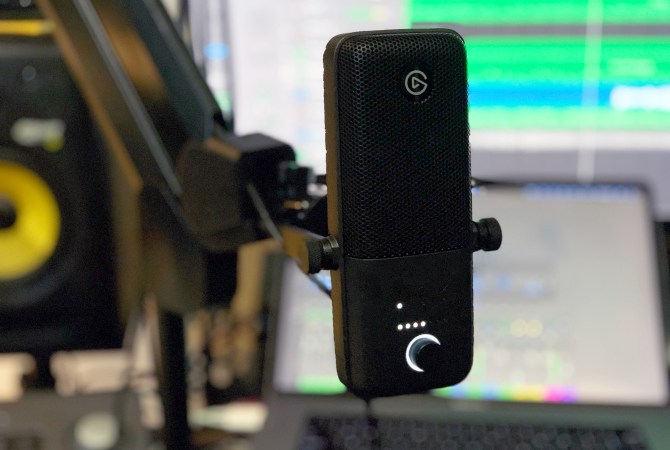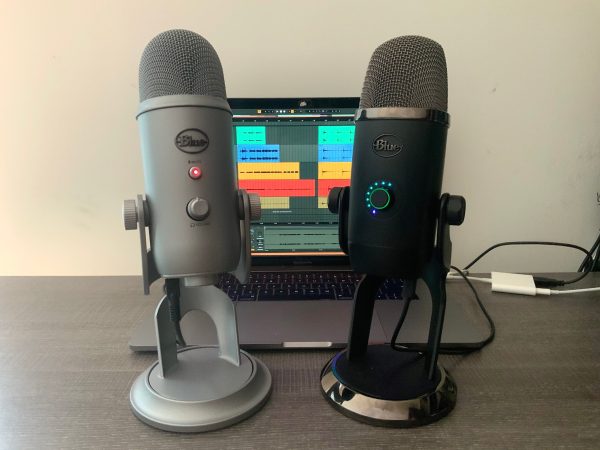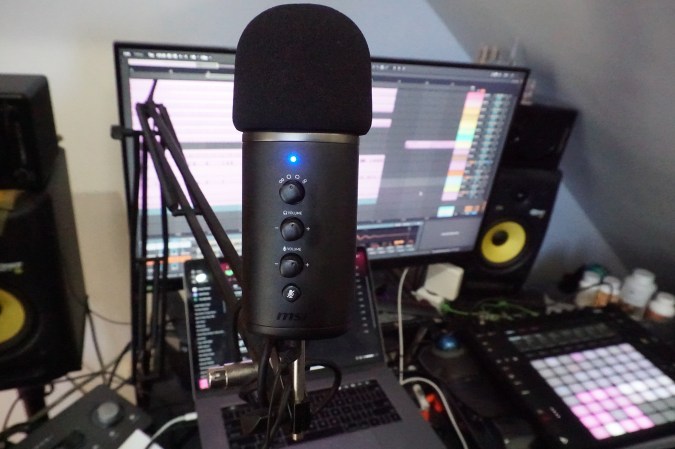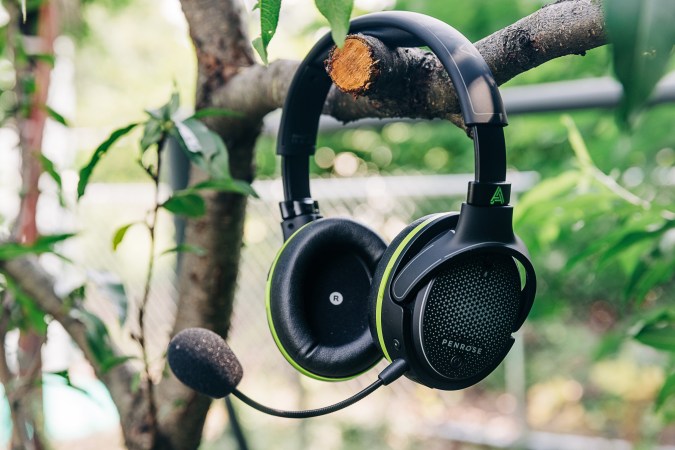

We may earn revenue from the products available on this page and participate in affiliate programs. Learn more ›
Online gaming has exploded as a broadcast medium, as well as an obsessive and interactive hobby, leading millions of Twitch streamers and MMORPG devotees in search of the best microphone for gaming. But not everyone has a sponsorship and Shure SM7B kind of money. The HyperX QuadCast S USB condenser microphone ($159.99) promises to help image-conscious players stand out—literally. A rainbow of RGB colors cascades down the microphone’s grille, helping it match similar lighting on some of HyperX’s other gaming-focused gear, such as the Alloy Elite 2 ($129.99) and Alloy FPS RGB ($109.99) keyboards, the Pulsefire Surge mouse ($54.99), and the Fury Ultra mouse pad ($54.99). The QuadCast S’s eye-popping multicolor lights and minimalist cylindrical design give it a unique look in the market space of desktop mics for gaming, which includes a variety of distinctive products like the Elgato Wave:3 or the entry-level Razer Seiren Mini. This HyperX QuadCast mic’s rare style alone makes it a great consideration for a YouTube microphone.
While HyperX squarely focuses on the gaming world—it’s what the company, recently acquired by HP, has dedicated itself to since 2014—the HyperX QuadCast S operates just the same as other USB mics, so it’s just as good of a device for streaming, podcasting, and recording as it is for marathon “Call of Duty: Black Ops Cold War” sessions.

| Pros | Cons |
| — The adjustable RGB lighting | — Not the highest resolution capture |
| — Mute button | — Ngenuity software only for PC |
| — Four pickup patterns | — Somewhat low mic input level |
| — Built-in headphone output |
The QuadCast S mic’s design
The USB-C QuadCast S updates the older, but still available, HyperX QuadCast micro-USB mic ($139.99). Both come with longer-than-usual, 3-meter cables that end in USB-A connections for plugging into Windows and Mac computers or Playstation 4 and 5 game consoles. So if you want a USB-C to USB-C connection for the QuadCast S, you’ll have to supply your own cable or adapter.
Besides the USB port type, the two microphones differ only by the lighting and color scheme. You can customize the HyperX QuadCast S’s RGB lighting from the Windows Ngenuity software, whereas the QuadCast features a static red backlight emanating from the mic’s grill, as well as red threading through the included shock mount. In addition to the removable shock mount, both models include a lightweight but robust metal stand and a shock mount adapter to mount them to standard boom arms or microphone stands with both 3/8 inches and 5/8 inches thread size.
The HyperX QuadCast S and QuadCast are the same weight and dimensions: 9.84 inches by 5.08 inches by 4.06 inches while in their stands and only 1.57 pounds total including the microphone, stand, shock mount, and USB cable. That makes them significantly lighter than arguably the most recognizable and popular USB mic for gaming, the Blue Microphones Yeti ($109, reviewed here), which is a total of 3.5 pounds including microphone and stand and still a common sight on Twitch, with famous streamers like DrLupo and Myth using it. The QuadCast is also more than 2 inches shorter than the Yeti, making it a bit more portable for taking to LAN parties, remote podcasting sessions, and so on.
Getting started with the QuadCast
I tested the HyperX QuadCast S on both a Mac laptop and a PS4 console. With the Mac, I simply plugged the mic into the machine with the included cable, selected “Hyper X QuadCast S” as both the sound input and output in the system settings, and was ready to go. After plugging the QuadCast S into a USB port of the PS4, it automatically set the mic as the input and output device, so I only needed to enter the menu to adjust the headphone output volume.
Because the QuadCast mics do not have volume level controls for their headphone outputs, if you want to listen to your system’s audio through their built-in headphone output, you have to use the volume controls from the computer or game console. In the case of Windows or Mac computers, that’s easy, because they tend to have accessible, hands-on volume controls. However, on PlayStation consoles, setting the level requires diving into the Audio Devices page of the Settings menu, which is not so quick to adjust.
For finding the right placement of the QuadCast S within your personal command center, the mic angles up and down within its included stand. There’s also an adapter accessory for detaching the QuadCast S from its stand and attaching it to nearly any third-party boom arm or mic stand. The adapter accessory works just fine, but when you unscrew the QuadCast S from its stand, two plastic washers fall out which are nearly impossible to put back. With its Yeti X, Blue Microphones figured out a washer-less design for detaching and reattaching a USB mic from its stand, and others should follow that lead.
The HyperX QuadCast S’s most distinct feature is clearly its RGB lighting. By default, these lights slowly morph through the different colors in the rainbow spectrum in a manner similar to the much larger light show adorning the JBL PartyBox 1000 speaker. Windows users can customize certain aspects of the QuadCast S’s lighting effects, such as the colors of the two “light-effect zones,” and the speed of their morphing movement. This HyperX Ngenuity software is Windows-only and still in beta even though it works with 20 total HyperX products. However, of all those products, only the HyperX microphones are Mac-compatible, and Windows machines dominate PC gaming so any Mac users will have to live without customizing their light show for the time being.
Key QuadCast and QuadCast S features

The HyperX mic’s RGB lighting isn’t the only interesting design feature of the QuadCast S. Both the QuadCast and Quadcast S have a touch-sensitive mute button on top that toggles the microphone input on and off. When the mic is off, the backlighting turns off. Because the on/off toggle is capacitive, you can activate it with your finger just slightly above it, without even physically touching it, or accidentally toggle it just by brushing it with your bare arm.
The microphone input level control is also cleverly located on the bottom of the mic, and you twist the entire bottom section to set the input sensitivity level.
A rear-facing switch selects from the four available pickup patterns—internal settings that focus the mic’s audio capture to specific areas in front, behind, or all around it. These four patterns are as follows: cardioid, which records only in front of the mic; bidirectional, which picks up in front of and behind the mic for face-to-face situations; stereo, a three-sided pickup pattern often used for recording musical instruments and sung vocals; and omnidirectional, which is sensitive to the entire ambient space all around the mic.
In addition to the included shock mount, which can help in suppressing unwanted noise from incidental contact with the mic and heavy vibrations, the QuadCast and QuadCast S also include a built-in pop filter, which is supposed to protect the mic from jarring plosive sounds like “Ps,” “Ts,” and “Ks.” In practice, neither the shock mount nor the built-in pop filter does as good of a job as the best professional accessories, but they are better than nothing.
HyperX QuadCast vs. Blue Yeti
The QuadCast/QuadCast S mics share similar internal features as the best-selling Yeti, such as three internal condenser capsules for capturing sound and a digital audio resolution of 16-bit/48kHz. Both QuadCast models have frequency responses of 20Hz-20kHz for microphone input and headphone outputs. That’s commonly cited as the average frequency range of human hearing so you won’t miss a single piercing detail of an alien enemy’s death shriek or an iota of rumbling thud from the mothership’s landing when listening from the headphone out (and no one on your team will miss your shrieks, either). The Yeti has an identical frequency response for its mic, though a wider range for its headphone output at 15Hz-22kHz (but you’re not likely to notice the difference in the middle of a heated raid).
Both the QuadCasts and the Yeti detach from their included stands to mount to boom arms and mic stands. But the Yeti does so a little more easily with its mounting threads on the bottom of the mic, rather than requiring an adapter like the QuadCasts.
Pricewise, the HyperX microphones command a premium for their striking backlights, and the QuadCast and QuadCast S cost $30 more and $50 more, respectively, than the Yeti. If you want a shock mount for the Yeti, however, the Blue Radius III costs an extra $49.99. But the real question remains: Does the higher QuadCast price also result in better sound than the Yeti?
The QuadCast sound
An audio resolution of 16-bit/48kHz won’t rank the QuadCast S among the best USB microphones for recording music, as musicians and producers often prefer to work with higher-resolution 24-bit audio. However, that audio definition should suffice for a gaming mic and for most other types of streaming. Just the same, I tested the QuadCast S by recording stringed and percussive instruments along with spoken and sung vocals, primarily comparing it to both the Yeti and the Yeti X, which, with its leveled-up audio resolution of 24-bit/48kHz and four condenser capsules (instead of three), is starting to replace the venerable Yeti on game streamers’ desks.
The QuadCast S and the Yeti share similar audio characteristics in that they both have a bright, crisp sound that captures very clear details in speaking and singing voices, as well as strummed instruments. If anything the Yeti occasionally exhibited an overly sharp tinge on “esses,” as well as other hard consonant sounds, whereas the QuadCast S seems to have a flatter representation of sound across the low-to-high frequency range. By comparison, the Yeti X, with its stepped-up hardware, delivers a subtly higher degree of clarity than the QuadCast S to voices and to other sounds, such as sustained instruments that sound a little richer and more textured.
The starkest difference between the sound of the Yeti and the QuadCast S concerned the input volume. With the other factors of pickup pattern, input gain level, and audio source being equal, the input signal of the Yeti is quite a bit louder than the QuadCast S. At its highest input level, the QuadCast S is sensitive enough to pick up very light sounds such as your clothes rustling as you adjust in your chair, breath sounds, and muted sounds leaking in from outside the room, so you still have to be careful to prevent unwanted sounds, and you can still do ASMR audio. But the Yeti is extraordinarily sensitive, to the point where you have to be very deliberate in finding its proper input gain level for your situation.
So, who should buy the HyperX QuadCast S?
There’s simply no way to decouple the multicolor RGB lighting of the QuadCast S microphone from your decision to purchase it. If lighting is your thing, that’s what should convince you to buy this HyperX mic—particularly if you’re inclined to complement the QuadCast S with other customizable RGB gear such as a keyboard and/or a mouse for gaming. If your priorities include a visually distinct USB microphone but also one that captures high-definition audio for recording, there are options like the AKG Lyra ($125) USB-C mic that targets musicians with 24-bit/192kHz audio and also showcases a trendy vintage radio mic style. Otherwise, the QuadCast S is a perfectly good gaming mic, as well as solid for podcasting and most other types of streaming content creation, with audio that offers a vast improvement over your computer’s internal mic.















